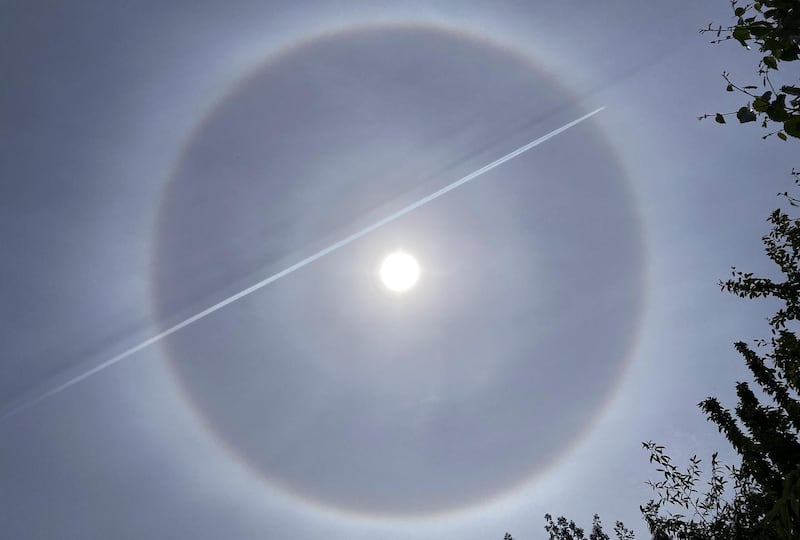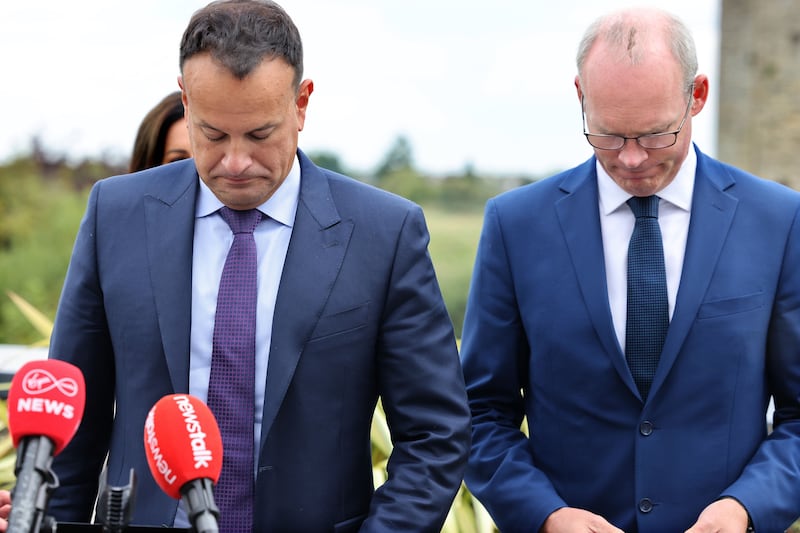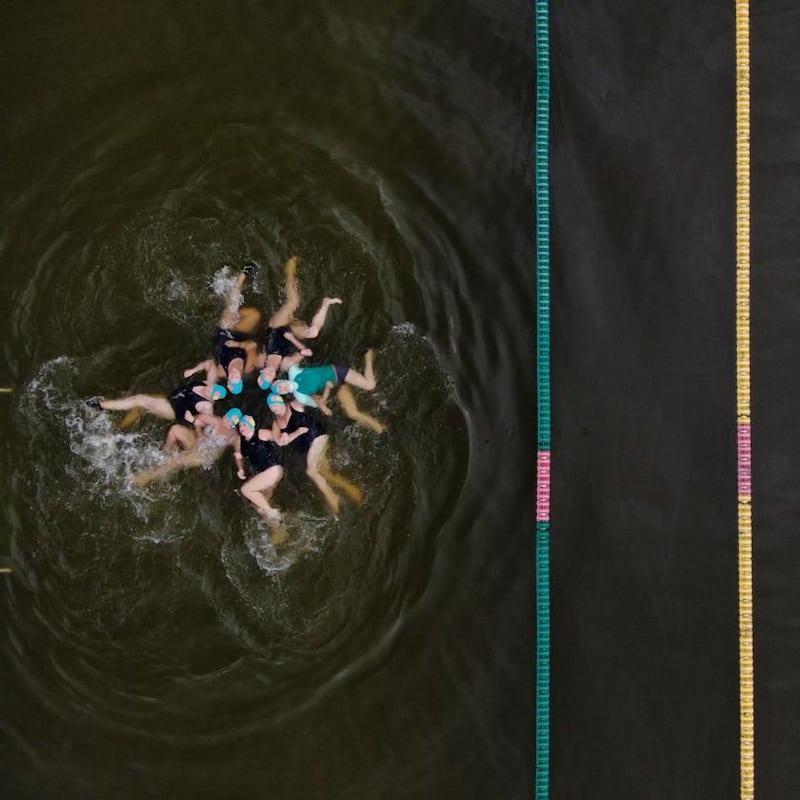Brenda Fitzsimons

It was a year of contrasts. Evocative images buffered the harrowing headlines that dominated our front pages, and this year we frequently turned to the arts, to nature and to sport for our more uplifting moments.
Running through a year of photographs, as seen through the pages of The Irish Times, can be like living through Groundhog Day. Has all that much really changed since January 1st? We saw queues at vaccination centres, and queues at Pennys. We saw pictures of Covid patients in hospital, and more of anti-lockdown demonstrations on our city streets.
Even as Covid continues to dominate, life and politics go on, and the job of the photographer is to make sure the important stories can continue to be told
Of all the images that gave me pause this year, the most striking was this shot of a starling murmuration over Lough Ennell, by James Crombie. This was no fluke photograph: Crombie spent months documenting these dazzling displays, and he was ultimately well rewarded for his patience in a photograph that went around the world.
We also looked to our Olympians for a welcome respite after Europe’s longest lockdown, and the scenes of Ellen Keane’s courage, and of Kellie Harrington’s homecoming gave us a much needed boost and chance for communal celebration. Then, proving that the sport doesn’t have to be Olympian to uplift, Alan Betson’s photographs of a community synchronised swimming fundraiser, and his accompanying story behind the shots were a favourite from the year.
Even as Covid continues to dominate, life and politics go on, and the job of the photographer is to make sure the important stories can continue to be told.
As politicians refine their public images with an ever more glossy polish, and increasingly attempt to keep press photographers away from the real stories, Dara Mac Donaill's picture of Leo Varadkar and Simon Coveney caught at an off-guard moment demonstrates the importance of his presence. The picture was taken ahead of the Dáil vote of no confidence over Coveney's handling of Katherine Zappone's UN appointment. Their expressions say it all.
Likewise, Laura Hutton’s persistence and determination made sure that she, and by extension we could all bear witness to the sentencing of John McClean. The former English teacher and rugby coach at Terenure College was sent to prison for eight years for the sexual abuse of 23 boys.
I was also drawn to images of contrasts, such as Tom Honan, showing us the tents of homeless people, seen against the shining towers of commerce; a pure homily on social justice. Then there was Nick Bradshaw's shot of an elderly man in his small oasis of greenery, defiant in the face of our city's continuing massive development.
As media messaging is honed, and the role of the press photographer eroded, these pictures show us the importance of dedicated professional photographers. And the joy they can bring.
Laura Hutton

On the morning of February 18th, John McClean, a former English teacher and rugby coach at Terenure College arrived at the Criminal Courts of Justice (CCJ) to be sentenced to eight years in prison for the sexual abuse of 23 boys between 1973 and 1990. He already knew he was going to jail, that’s why he is carrying an overnight bag in the image.
McClean hadn’t yet been photographed arriving at court. I knew he must have been going in early to avoid the press, so I set up before 8am, for an 11am sentence hearing. It was just me and an RTÉ news cameraman, waiting on the day. It’s a rarity to get an exclusive set of news images like this, but that’s what I had: the last images of John McClean before he went to jail.
The photographer and the news camera operator come to act as the eyes of the public. You are entitled to see who is on trial, and it is our job to show you
You don’t get much time to shoot someone arriving for court. At the CCJ you hope they come the way McClean did that morning – walking up the access ramp. This gives you time to shoot on a long lens getting clean, tight shots. You then change to a wide angle camera as they get closer.
One of the goals of a successful courts image is to get the subject’s eyes in the frame. Here, because McClean was wearing a cap and a facemask, I knew the opportunity was small. As he got closer to the doors, I got as low to the ground as I could, to shoot under his cap while still trying to keep the overnight bag in the frame. Even so, the shadow of his cap means his eye is barely visible.
Most criminal trials are open to the public but space is limited. The photographer and the news camera operator come to act as the eyes of the public. You are entitled to see who is on trial, and it is our job to show you. We take this seriously, and endeavour to show the faces of those charged with serious crimes. Those charged with sexual crimes are a priority. It is often noted that a photograph and story about someone accused of such crimes can help other victims to come forward. They know they are not alone.
Courts photography isn’t always the most creative or exciting, but it is an essential public service in an open justice system.
Bryan O’Brien

In photojournalism you don’t always have to go to exotic locations to make good photographs, but you do usually have to at least leave the house. This photograph is an exception to that rule as it was made in the garden of my Dublin home.
It was midday on Thursday, May 27th. I was editing a video project when I got a text photo from a colleague showing an unusual looking halo in the sky. I went out into the garden and sure enough to the south, and almost directly overhead, there was this really unusual large circle of light with the sun at its centre.
I’ve learned over many years to always make the photo first, and worry about the details after. Situations and light change quickly. So, even though I had no idea what I was looking at, it looked good.
It is a rare optical phenomenon known as a 22 degree halo, which can appear around either the sun or the moon
It can be dangerous to look through a camera towards the sun, so I used a built-in screen to make a couple of exposures. The light intensity was high, so I also added a neutral density filter to reduce it. I shot test photos and made adjustments until I was happy with the exposure, and included foliage in the frame to give perspective.
The photos were fine but they still weren’t quite capturing what I needed to give a real sense of what I was seeing. That’s when I got lucky. There weren’t a lot of planes in the sky then, but there was one on this morning. I’m guessing it was crossing Ireland on its way towards the US from the UK. The jet vapour trail appeared and crossed the halo, and I was delighted. I made half a dozen exposures, but the one that worked the best is where the plane appears to come out the far side of the circle.
I started to load up the photos to my laptop and finally had a chance to Google “sun halo” to try and figure out what I had just witnessed. It is a rare optical phenomenon known as a 22 degree halo, which can appear around either the sun or the moon. If I understand it correctly, it is formed as sunlight is refracted by millions of ice crystals suspended in clouds in the upper atmosphere at a precise angle of 22 degrees. I guess you learn something new every day.
Dara Mac Dónaill

Taken on September 14th, this photograph appeared on the front page of The Irish Times the next day, as the Minister for Foreign Affairs and deputy leader of Fine Gael, Simon Coveney, was about to face a no-confidence motion in the Dáil.
It was taken during a media briefing at the Fine Gael Think-in, at Trim Castle Hotel, Co Meath. As a photographer, you can spend hours, if not days, waiting for your shot, and I had already been attending every session I could, trying to capture something interesting.
The previous few weeks had been overshadowed by the controversy over Katherine Zappone’s appointment as Ireland’s special envoy to the UN on Freedom of Opinion and Expression, so I was keeping a keen eye on Minister Coveney. Cameras had been allowed to be present for the first few minutes of Party leader and Tánaiste Leo Varadkar’s opening address, but I didn’t feel I had captured anything out of the ordinary yet.
They reminded me of two nervous school boys standing in line, about to be reprimanded
The day went on. There was a press briefing, but unfortunately Minister Coveney was not there. Then there was a tea break on the rooftop of the hotel. Parliamentary party members were mixing and chatting, and as soon as Minister Coveney arrived, all camera lenses turned to him.
As ever, I was looking for a different picture, but it was difficult: like any get- together of friends who haven’t met up in person for a long time, it was all smiles, jokes and happy faces.
Looking for that something different is actually about trying to find a moment of truth. You’re hoping to get behind a facade. It can take an awful lot of waiting, but I knew I wasn’t there yet. Another media briefing was announced, this time including Minister Coveney: my final opportunity, before he faced his no-confidence vote.
This image was one of the very first photographs I took, at the beginning of the briefing. Both Varadkar and Coveney happened to look down at the same time, checking to see they were presentable for the cameras. They reminded me of two nervous school boys standing in line, about to be reprimanded.
Minister Coveney went on to survive the vote.
Alan Betson

It’s early September and hoots of laughter permeate the chilly air at the Clontarf Baths. A multitude of bright blue frilly swimming cap-clad synchronised swimmers bob around in the chilly green seawater, mostly (though not always) in time, to the blaring Abba soundtrack. Declan, the only male amongst 21 of Ireland’s first charity synchronised swim team has received an unintentional kick in the groin from his wife Siobhán. They were practicing a tumble in advance of the St Francis Hospice Raheny fundraiser. Behind my camera, I find the laughter infectious.
The noisy wasp like gadget now sits alongside the many high-quality tools, such as go-pro, smart phone and mirrorless cameras which bolster a photographer's story-telling armoury
It becomes the reoccurring theme over six weeks, as I pop in regularly to document the group's steadily improving moves. Synchronised swim teacher Aoife Drumm is on a mission with a looming deadline. The routines are quick as the water is cold, We Will Rock You is followed by Gimme, Gimme, Gimme.
The raised viewing areas at the baths provided a good view of the proceedings, but this really was a job for the drone. The noisy wasp like gadget now sits alongside the many high-quality tools, such as go-pro, smart phone and mirrorless cameras which bolster a photographer’s story-telling armoury.
This is a great little story about a brave group of individuals getting together to try something new, pushing outside their comfort zones, all for a very good cause.



















